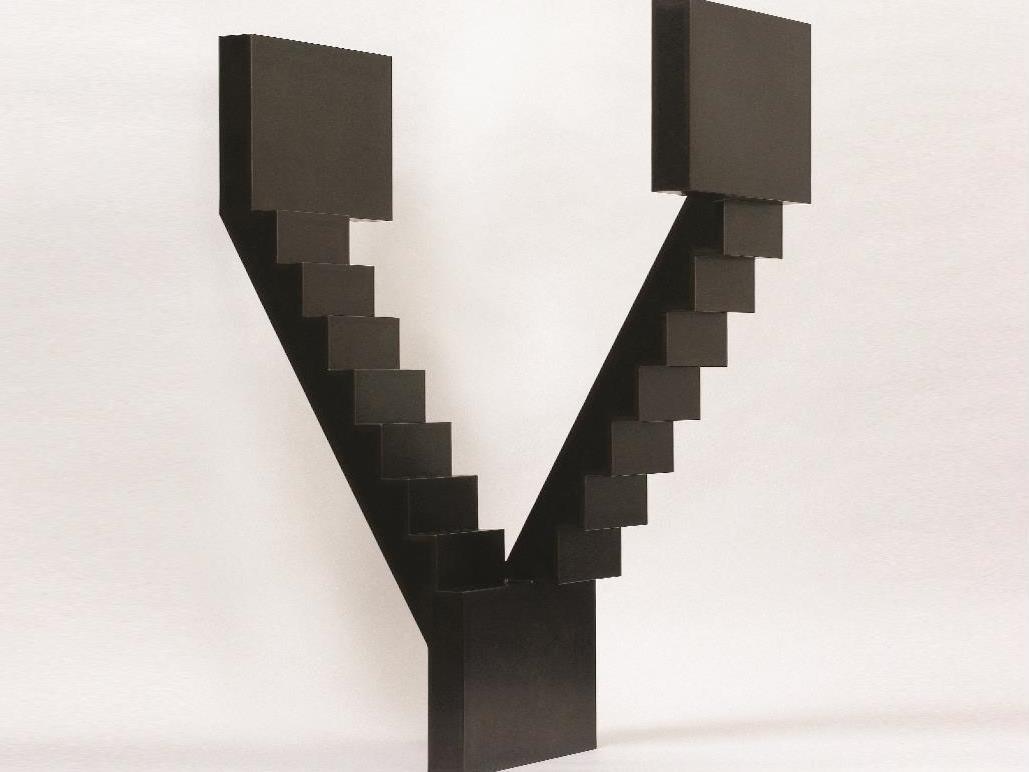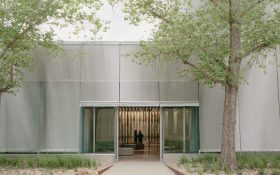Kensuke Todo, Apex (2008), mild steel, 105 x 77.6 x 37 cm. Collection of Canberra Museum and Gallery.
The mild steel sculptures of Japanese-born, Canberra-based artist Kensuke Todo are an exercise in austerity. They are a far cry from the phantasmagoric creations we have come to associate with contemporary Japanese artists Hiromi Tango, Tahashi Murakami, Yayoi Kusama – and, lest we forget, Yoko Ono – all of whom have made successful forays into the Western art scene. No, you wouldn’t catch Todo constructing a portable ‘womb’ so that he may have some experience of life in utero (Hiromi Tango did just this in 2011), or, in the case of Kusama, orchestrating a ‘Grand Orgy to Awaken the Dead’. By comparison, the tone of this exhibition is verging on ascetic.
Born in 1975 in Kyoto, Todo relocated to Canberra in 2003, completing a Master of Visual Arts and becoming an Artist in Residence at the ANU’s School of Art. This is his first exhibition at the Drill Hall, having featured in several solo shows and group exhibitions at Sydney’s King Street Gallery. Todo seriously contemplated a career in architecture, and indeed, many of his sculptural forms tend toward the architectural – there are staircases, highway ramps and escalators, all rendered in isolation from any broader urban environment.
Many of these works imply a juxtaposition between modern Australian and traditional Japanese sensibilities. This is most evident in the ‘futon’ works, which take the traditional Japanese bedding material as their subject. In Equal and Opposite (2013), the futon is forcibly crushed by a sleek modernist oblong, perhaps alluding to inter-cultural tensions. Todo achieves a very convincing rendition of contrasting textures using the one medium; the futon appearing soft and pliable, the rectangular prism dense and sharply edged. This dislocation between appearance and actuality is redolent of Ricky Swallow’s oddly titled Caravan (2008) in the Museum of Contemporary Art. One feels as though they could almost kick Swallow’s bronze balloons across the room, and yet to attempt to do so would only be to suffer a very sore foot.
Cultural disparities are also apparent in Todo’s conception of space. In Australian art – and particularly the paintings of mid-century modernists Nolan, Drysdale and Williams – the horizontal axis performs an expansive function; the high horizon is used to infinitely extend the picture plane. In Todo’s sculptures, however, the influence of traditional Japanese art and design is made manifest: the horizontal axis is used to delineate space; to precipitate fields of tension. Works such as Apex (2008) also demonstrate Todo’s sophisticated sense of negative space: the flat white gallery wall completes the image when juxtaposed against the black undulating form before it. In spite of the title, the two arms of the sculpture rise up but never meet. Instead, their flattened topmost sections face one another, the implied horizontal axis generating a kind of magnetism.
In the sculptures of escalators and highways, Todo identifies an austere beauty in otherwise mundane, utilitarian subjects. In Takashimaya (2007), two intersecting escalators take the form of an algebraic ‘x’, their implied mechanical movement producing a fluid kind of symmetry. In Junction III we are again reminded of Todo’s Japanese heritage – as a nation of many islands, Japan depends on a complex network of highways and railroads. Probably not since Jeffrey Smart’s Cahill Expressway (1962) have entry and exit ramps taken such pride of place in a work of art.
In many of Todo’s works there is a kind of paradox: though obviously informed by man-made structures, his sculptures are bereft of any human presence. Moreover, there is something dispiriting about their deliberate incompleteness: the escalators, highways and stairs lead nowhere, for no one. In spite of the superb curatorship of Peter Haynes, I suspect that for this reason Todo will not be everyone’s cup of tea.
Rating: 4 out of 5 stars
Kensuke Todo: A Survey
ANU Drill Hall Gallery, Kingsley Street, Acton, ACT
www.anu.edu.au
23 May – 29 June





